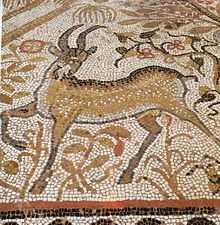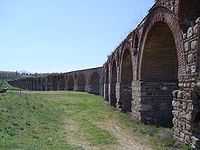Architecture of the Republic of Macedonia
Architecture of the Republic of Macedonia refers to architecture ever practised on the territory of present-day Republic of Macedonia.
The several groups of people that have settled or controlled today's Republic of Macedonia have influenced the country in many ways; one of the most visible being architecture. These groups of people include the Paionians, Illyrians, Ancient Macedonians, Romans, Byzantines, Bulgarians, Serbs and the Ottomans.
Early architecture
Megaliths
The earliest example of architectural activity in Macedonia date from the Neolithic and consist of structures associated with Megalith culture. Kokino is the fourth oldest megalithic observatory in the world. The site consists of rocks crafted in a way that lets one observe celestial objects.[1]
The architecture of Ancient Macedonia


Remnants of the architecture from the times of the ancient Macedonian Kingdom are scattered throughout the Republic of Macedonia, especially in the south of the former territory of Macedon
Heraclea Lyncestis, founded in the middle of the 4th century BC, was an important strategical town as it bordered Epirus to the west and the Paeonian kingdoms to the north. Roman architecture dominates the site today because of the level of the excavations which are exposing the layers from the Roman times
The Antique Theatre in present-day Ohrid was built during the 1st century BC. It was part of the ancient town of Lychnidos. It is reconstructed and in use today. Its location between two hills that surround it keep it protected from winds that could interfere with acoustics during performances.
Roman architecture

Roman architecture is scattered throughout the country. Skopje is home to a few examples of this type of architecture. One is the Skopje Aqueduct, the only aqueduct in Macedonia. It consists of 55 stone arches. Another example is Scupi. Although not much remains of this archaeological site, burial grounds and a theatre are somewhat visible.
Although it was founded by the Ancient Macedonians, most of the remains of Heraclea Lyncestis are from Roman occupation. These remains include a portico and a large theatre.
Other examples of Roman architecture in the Republic of Macedonia includes the many Roman ruins in and around the town of Strumica. One of the largest is a well-preserved Roman therma, built during Late Antiquity.
Byzantine architecture
Byzantine architecture is one of the most prominent forms of architecture in the Republic of Macedonia. It is mostly seen in churches and monasteries, such Treskavec monastery near Prilep.
Ottoman architecture
The Ottomans controlled the land of present-day Macedonia for about five centuries. They left their mark with the many mosques and other Islamic buildings they constructed.
Ottoman architecture is predominant in some parts of Skopje, especially the city's old town. Mustapha Pasha Mosque is one of the most famous Ottoman buildings in Macedonia. Built in 1492, the mosque is square in shape and the diameter of the dome is 16 meters. The pillars of the porc hare decorated by stalactite decorations that are typical of Ottoman architecture.[2]
Ottoman architecture can also been seen in Bitola and Tetovo.
Neoclassical architecture
Examples of neoclassical or baroque architecture are throughout the country but can be rare and limited to one structure per city. Neoclassical architecture can be seen in Skopje (Ristiḱ Palace). The exception to this pattern is in Bitola. Širok Sokak street is filled with neoclassical and baroque architecture and a Gothic Catholic church.
Modern architecture
Most of the modern buildings in Macedonia are located in central Skopje. One example is the MRT Center (the national TV broadcast station), which is the tallest building in the country, rising to 230 ft (70.10 m) (70 m).
Examples of modern architecture are also found in other cities, mainly Bitola and Gostivar.
Skopje 2014
Skopje 2014 is a project first announced by the government in early 2010 that will foresee the construction several buildings, mostly in the neoclassical style which has drawn criticism from architects as being kitsch.
References
| |||||||||||||||||||||||||||||||||||||||||||||||||||||||||||
| ||||||||||
